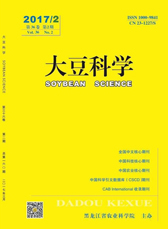[1]James 2016. http://www.isaaa.org/resources/publications/pocketk/16/default.asp. [2]Bonny S. Herbicide-tolerant transgenic soybean over 15 years of cultivation: Pesticide use, weed resistance, and some economic issues: The case of the USA[J]. Sustainability, 2011, 3(9):1302-1322.
[3]Ding W, Li X H, Wang Z H. Benefits, potential risks and environmental safety assessments of herbicide-resistant transgenic soybean[J].Journal of Northeast Agricultural University, 2011, 18(3):65-70.
[4]赵波, 张鹏飞. 抗除草剂转基因大豆的生态安全评价进展[J]. 山地农业生物学报, 2012, 31(1):70-76.(Zhao B, Zhang P F. Ecological assessment of transgenic soybean tolerant to herbicide[J]. Journal of Mountain Agriculture and Biology, 2012, 31(1):70-76.)
[6]Li L, Yang X, Wang L, et al. Limited ecological risk of insect-resistance transgene flow from cultivated rice to its wild ancestor based on life-cycle fitness assessment[J]. Science Bulletin, 2016, 61(18):1440-1450.
[7]宋小玲, 强胜, 彭于发. 转EPSPS基因大豆(Glycine max(L)Merri)杂草性评价的试验实例[J]. 中国农业科学, 2009, 42(1):145-153. (Song X L, Qiang S, Peng Y F. An experimental case of safety assessment of weediness of transgenic glyphosate-resistant soybean [Glycine max (L) Merri][J]. Scientia Agricultura Sinica,2009,42(1):145-153.)
[8]Nishizawa T, Nakajima N, Aono M, et al. Monitoring the occurrence of genetically modified oilseed rape growing along a Japanese roadside: 3-year observations[J]. Environmental Biosafety Research, 2009, 8(8):33-44.
[9]Saji H, Nakajima N, Aono M, et al. Monitoring the escape of transgenic oilseed rape around Japanese ports and roadsides[J]. Environmental Biosafety Research, 2005, 4(4):217-222.
[10]Kawata M, Murakami K, Ishikawa T. Dispersal and persistence of genetically modified oilseed rape around Japanese harbors[J]. Environmental Science & Pollution Research, 2009, 16(2):120-126.
[11]Yoshimura Y, Beckie H J, Matsuo K.Transgenic oilseed rape along transportation routes and port of Vancouver in western Canada[J]. Environmental Biosafety Research, 2006(5):67–75.
[12]Busi R, Powles S B. Transgenic glyphosate-resistant canola (Brassica napus) can persist outside agricultural fields in Australia[J]. Agriculture Ecosystems & Environment, 2016, 220:28-34.
[13]朱元招, 尹靖东, 李德发,等. 转抗草甘膦基因大豆PCR定量检测研究[J]. 中国农业大学学报, 2005, 10(3):25-29.(Zhu Y Z, Yin J D, Li D F, et al. Quantitative PCR method for detecting glyphosate-tolerant gene transfer in soybeans[J]. Journal of China Agricultural University,2005 , 10(3):25 -29.)
[14]田芳, 王秀敏, 滕达,等. 转抗草甘膦基因大豆及其加工产品的环介导等温扩增检测技术[J]. 中国畜牧兽医文摘, 2011, 23(3):480-485.(Wang F, Wang X M, Teng D, et al. A loop-mediated isothermal amplification to detect genetically modified soybean resistant to glyphosate and its processed products[J].Chinese Abstracts of Animal Husbandy and Veterinary Medicine,2011,23(3):480-485.
[15]Yoke K C, Yee T C, Siew P K, et al. Development of multiplex-PCR for genetically modified organism (GMO) detection targeting EPSPS and Cry1Ab genes in soy and maize samples[J]. International Food Research Journal, 2011,18:517-522.[16]邢珍娟,李飞武,刘娜,等转EPSPS基因大豆植株中蛋白的表达[J].大豆科学,2009,28(6):981-984,989. (Xing Z J, Li F W, Liu N, et al. Expression of CP4 EPSPS protein of genetically modified roundup ready soybean[J],Soybean Science,2009,28(06):981-984,989)
[17]于惠林, 杨鑫浩, 肖娅风,等. EPSPS蛋白在转基因耐草甘膦大豆植株中的表达量测定[C]长沙:第十一届全国杂草科学大会论文摘要集,2013. (Yu H L, Yang X H, Xiao Y F, et al.Expression of EPSPS protein in transgenic glyphosate tolerant soybean plants[C]. Changsha:Abstracts of proceedings of the Eleventh National Weed Science Conference,2013.)
[18]Liu M, Li D, Wang Z, et al. Transgenic expression of ThIPK2 gene in soybean improves stress tolerance, oleic acid content and seed size[J]. Plant Cell Tissue & Organ Culture, 2012, 111(3):277-289.
[19]沈晓峰, 栾凤侠, 陶波. 转抗草甘膦基因大豆生物与环境安全性[J]. 东北农业大学学报, 2007, 38(3):401-404.(Shen X F, Luan F X, Tao B. Biosafety and environmental safety of genetic modified soybean resistant to glyphosate[J].Journal of Northeast Agricultural University, 2007, 38(3):401-404.)
[20]Damgaard C,Kjaer C.Competitive interactions and the effect of herbivory on Bt-Brassica napus, Brassica rapa and Lolium perenne[J].Journal of Applied Ecology, 2009, 46(5): 1073-1079.
[21]Laughlin K D,Power A G,Snow A A,et al.Risk assessment of ge-netically engineered crops: Fitness effects of virus-resistance transgenes in wild -Cucurbita pepo[J]. Ecological Applications, 2009, 19(5):1091-1101.
[22]Zeller S L,Kalinina O,Brunner S, et al. Transgene × environment interactions in genetically modified wheat[J].Plos One,2010,5(7): e11405.
[23]Orr H A. Fitness and its role in evolutionary genetics[J]. Nature Reviews Genetics, 2009, 10(8):531-539.
[24]浦海清,王健,陈良燕,等.转基因植物的生态适合度研究现状与展望[J].江苏农业科学,2012,40(10):41-44.(Pu H Q, Wang J, Chen L Y, et al. Current situation and prospect of ecological fitness of transgenic plants[J]. Jiangsu Agricultural Sciences,2012,40(10):41-44.)
[25]苏军,宋亚娜,姚玉仙,等.转CryIAb水稻在不同生长条件下的适合度[D]. 分子植物育种,2013,11(4):469-476.(Su J, Song Y N, Yao Y X, et al. Fitness of transgenic insecticidal rice under different growing condition[J].Molecular Plant Breeding,2013,11(4):469-476.)
[26]Yang X, Wang F, Su J, et al. Limited fitness advantages of crop-weed hybrid progeny containing insect-resistant transgenes (Bt/CpTI) in transgenic rice field[J]. Plos One ,2012,7(7): e41220.
[27]王永慧. 温湿度逆境、棉铃大小和生长物质对Bt棉Bt蛋白表达量的影响及其生理机制[D]. 扬州:扬州大学, 2010.(Wang Y H. Effects of combination of temperature and humidity, boll size, growth substances on Bt protein expression and metabolism for Bt cotton[D]. Yangzhou:Yangzhou University,2010.)
[28]张桂玲, 温四民. 盐胁迫对转Bt基因棉苗期Bt蛋白表达量和氮代谢的影响[J]. 西北农业学报, 2011, 20(6):106-109(Zhang G L, Wen S M. Effects of salt stress on bt protein content and nitrogen metabolism of transgenic Bt cotton[J]. Acta Agriculturae Boreali-occidentalis Sinica, 2011, 20(6):106-109.)
[29]陈源, 韩勇, 花明明,等. 低温和湿度胁迫对盛铃期Bt棉叶片Bt蛋白表达量的影响[J]. 棉花学报, 2014, 26(4):29.(Chen Y, Han Y, Hua M M, et al. Effect of stresses of low temperature and different relative humidity on the bt protein content in leaves at the bolling stage in Bt cotton[J]. Cotton Science, 2014, 26(4):29.)

